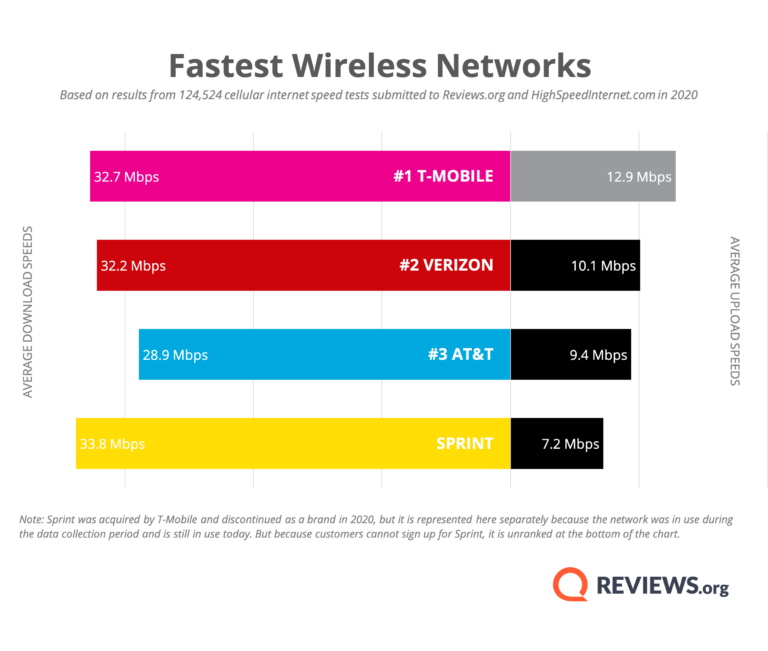Reach uses T-Mobile’s network to provide coverage for its users, which isn’t quite as reliable as Verizon’s network. Still, if you want an unlimited plan at the fraction of the price and contribute some of your bill to charity, Reach Mobile could be perfect for you. Unfortunately, Reach Mobile has one of the lowest data caps we’ve ever seen on an unlimited data plan. It’s just 20 GB, which many people can burn through in a week or less. So, if you need a reliable, high-speed data plan for Zoom meetings at work, you might want to go with Verizon. But the bad news doesn’t really end there. Reach’s data will never be as reliably fast as Verizon’s, even before you reach the data cap. That’s because the company is an MVNO and its customers will always be at risk of having their data deprioritized (slowed down) when the network is congested. Reach has partnered with programs that provide cell phones and service to women in poor and rural areas throughout the globe. You can use the Reach Mobile app to see just how much talk, text, and data you’ve contributed to Reach’s program. But Verizon’s four unlimited data plans are a different story. These plans are some of the most powerful on the market. Here’s what you need to know about them.
All of these plans come with unlimited talk, text, and data, access to Verizon’s 5G network, and cool perks like a 6-month Disney+ subscription (which we highly recommend). 5G Start Plan is the cheapest and simplest of these plans. It has no hard data cap but on this plan your data can always be slowed down due to deprioritization (much like on Reach’s plans). You don’t get any mobile hotspot data. 5G Play More Plan has a 50 GB high-speed data cap and DVD-quality video streaming. It comes with 25 GB of mobile hotspot data and cool business perks to help you get more work done, like 600 GB of Verizon Cloud storage. 5G Do More Plan has 5G total access, 50 GB high-speed data cap, unlimited HD video streaming, and 25 GB of hotspot data. . 5G Get More Plan basically combines the plans above, giving you 5G total access, unlimited premium network access, all the subscriptions, and a full 50 GB of mobile hotspot data. You’ll get free subscriptions to Hulu, ESPN, and Disney+ with this plan
In short, Verizon’s unlimited plans are pricey powerhouses that will satisfy those who work, game, stream, and post on their phones all day. Here’s an example to illustrate the difference. Let’s say you, your spouse, and your two kids all want unlimited data plans. If you sign up for a four-line unlimited data plan from Reach, it will cost you more than if you signed up from Verizon. Take a look. Verizon, meanwhile, offers pretty awesome deals on all of its plans when you add extra lines. If you’ve got more than one person who wants a cell phone plan in your family, there’s really no reason to not bundle together with Verizon. Verizon technically covers more of the United States than T-Mobile, but it’s still a pretty close call. Take a look at the coverage maps below to get an idea of the coverage difference: Verizon coverage map If you want a new flagship phone from a major company, like the Samsung Galaxy S22 and the iPhone 13, then Verizon has a way better selection. But Reach comes in with some sweet deals on cheaper devices, like the Pixel 6. These WhistleOut charts will show you the most popular phones that each company is selling right now. Plans: Reach’s plans are relatively affordable and offer a decent amount of data, but data slowdowns and price changes will drive many away. Verizon’s plans aren’t the cheapest, but otherwise they’re basically the best if you like tons of data, great coverage, and fast speeds. Family plans: Verizon is the clear winner in this category because it offers steep discounts on multi-line plans. Reach, on the other hand, offers no family plan discounts or perks to speak of. Coverage and performance: Reach uses T-Mobile to provide network coverage and Verizon uses (you guessed it) Verizon. Verizon offers more coverage overall, but T-Mobile makes up for it with faster average data speeds. Since Reach Mobile is an MVNO carrier, your data speeds can be throttled when the network gets busy. Then we used our own proprietary data from over 100,000 customers, as well as online customer reviews, to rate the performance of each carrier in several categories, including data speed and data deprioritization. We looked at the fine print to understand how price changes, phone deals, and other aspects of each carrier’s service can affect potential customers. We think our final review looks at every angle, providing our readers with useful information and honest recommendations. You can read our article about how we rate cell phone plans if you’d like to learn more about our process. Data: You need data for pretty much everything—streaming, gaming, posting, working, etc. So make sure your plan has enough data to support your habits. Price: Cell phone plans are cheaper than they used to be. You can make sure you’re getting the best price available using tools like WhistleOut’s comparison charts (seen in this article). Coverage: There are three major networks in the US. Check coverage maps to see which one has the best coverage in your city or town. Features: Special features like hotspot data, international benefits, and HD video streaming aren’t included in every plan. Read through the fine print to make sure you’re getting all the features you want before you sign up. Verizon’s cheapest unlimited data plan is the 5G Start Plan, which costs $70 a month (or $60 if you’re a first responder or teacher or student).

